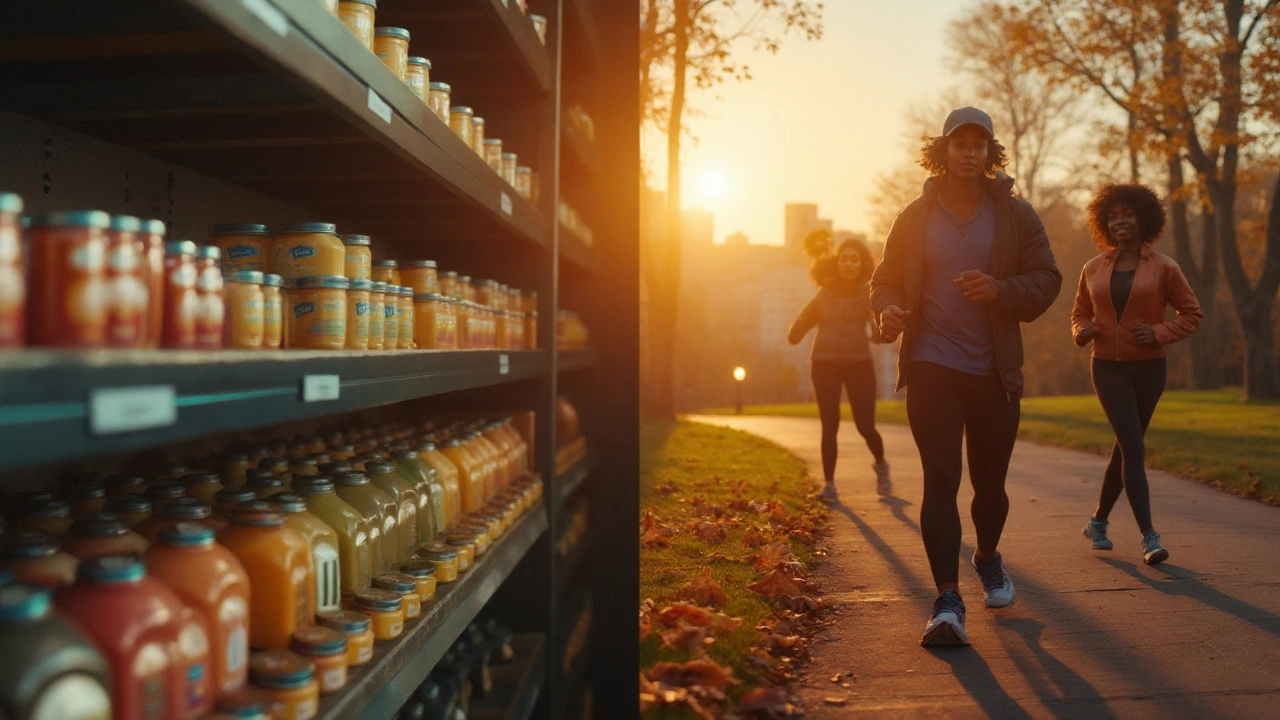If detox teas, patches, and seven-day cleanses worked the way the ads claim, your liver would be redundant. That’s the awkward truth: your body already runs a 24/7 detox operation. The real question isn’t “How do I detox?”-it’s “How do I stop getting in my body’s way and avoid getting scammed?” Here’s the evidence, the practical stuff that actually helps, and where you should get medical help instead of doing it yourself.
TL;DR / Key takeaways
- Your liver, kidneys, lungs, skin, and gut already detoxify you. No tea or juice can “flush toxins” faster than those organs do naturally.
- Short cleanses may cause quick weight drops, but it’s mostly water and glycogen. The weight typically rebounds when you eat normally.
- Evidence for commercial detox programs is weak to nonexistent. An Australian-led 2015 review (Journal of Human Nutrition and Dietetics) found no strong, controlled trials showing meaningful toxin removal or lasting weight loss.
- There are risks: dehydration, electrolyte imbalance, low blood sugar, interactions with meds, and for alcohol/benzodiazepines-dangerous withdrawal.
- What actually helps: less alcohol and ultra-processed foods, enough protein and fiber, hydration with electrolytes when needed, sleep, movement, and time.
What detox really means (biology vs marketing)
I live in Melbourne, and every summer there’s a wave of “cleanse” chatter, usually right after the first heatwave and before footy finals. Let’s sort the biology from the buzzwords.
Detoxification, in medicine, means the body’s process of breaking down and removing compounds-everything from normal metabolic byproducts to alcohol and certain pollutants. The heavy lifting happens in your liver and kidneys:
- Liver: It runs enzyme systems (often called Phase I and Phase II) that transform fat-soluble substances into water-soluble ones, so you can excrete them in bile or urine.
- Kidneys: They filter roughly 150-180 liters of plasma a day, fine-tuning electrolytes and removing waste products and many drug metabolites through urine.
- Gut: Bile carries waste into the intestine; fiber binds some compounds and helps them exit in stool.
- Lungs and skin: You exhale volatile compounds and sweat water and electrolytes; sweat isn’t a major route for most toxins compared with urine and feces.
Marketing uses “detox” to sell cleanses, teas, patches, foot baths, and supplements. These products rarely define what “toxins” they remove or provide before-and-after lab data. When studies exist, they’re usually tiny, uncontrolled, or measure surrogate endpoints (like short-term weight change) rather than actual toxin levels.
What the research does say: an Australian review (Klein & Kiat, 2015) examined popular detox programs and found no strong evidence that they eliminate toxins or support sustained weight loss. Health agencies echo this. The NHS in the UK and Australia’s NHMRC consistently advise focusing on diet quality, alcohol reduction, movement, and sleep instead of restrictive “detoxes.” The Therapeutic Goods Administration (TGA) has also flagged issues with certain herbal laxatives (like senna) used in “detox teas.”
So if you feel sluggish, bloated, or off-track, the fix isn’t a miracle cleanse. It’s dialing in the basics that make your internal detox machinery work smoothly.
A safe, practical 7‑day reset that actually supports detox
This is not a crash plan. It’s a one-week reset that reduces load on your system and supports the pathways that already work for you. If you take prescription meds, are pregnant, breastfeeding, have diabetes, kidney or liver disease, or a history of eating disorders, check with your GP before changing your diet or fasting patterns.
- Food baseline
Aim for plate balance at most meals: half non-starchy veg, a palm of protein, a cupped hand of whole carbs, and a thumb of healthy fats. That covers micronutrients your enzymes need (think B vitamins, magnesium, sulfur-containing amino acids) with no spreadsheets required. - Protein target
Shoot for about 1.2 g per kg body weight per day if you’re healthy and moderately active (e.g., 84 g/day for a 70 kg person). Protein gives your liver the amino acids it needs for conjugation steps and helps maintain lean mass during calorie dips. - Fiber floor
Work up to 30-40 g/day. Mix insoluble (whole grains, bran, veg skins) and soluble (oats, legumes, chia). Fiber supports regular bowel movements, binds some bile acids, and feeds gut microbes that produce beneficial short-chain fatty acids. - Hydration with a plan
Use a simple rule: 30-35 ml/kg/day water as a baseline, more on hot days or with workouts. Add a pinch of salt and a splash of citrus to one bottle if you sweat a lot; electrolytes help you keep the water you drink. - Alcohol holiday
Go alcohol-free for the week. Your liver prioritizes alcohol metabolism over other tasks; taking a break frees capacity. Australian NHMRC guidelines suggest no more than 10 standard drinks a week and no more than 4 in any day-use this week to reset your baseline. - Coffee isn’t the enemy
1-2 coffees a day is fine for most people and may even support liver health in observational research. Skip the sugary syrups; keep it simple. - Move daily, sweat sensibly
Target 30-45 minutes of moderate activity most days: brisk walk, cycling along the Yarra, swimming laps. If you like sauna, 10-15 minutes is okay if you rehydrate and replace electrolytes-but sweating is not your main detox route, so don’t overdo it. - Sleep like it matters
7-9 hours. Your brain clears metabolic byproducts more efficiently during deep sleep. Even one late night can nudge hunger hormones and push you toward comfort food. - Lighten the load on your gut
For seven days, sidestep ultra-processed foods, deep-fried takeaways, and heavy late dinners. If you want a simple eating window, try 12:12 (e.g., 7 am-7 pm). It’s gentle, social-life-friendly, and helps appetite regulation without harsh fasting. - Supplements? Keep it boring
If you want a helper, stick to basics with good safety profiles: a standard multivitamin if your diet is patchy, and maybe psyllium husk for fiber. Be cautious with “liver detox” blends-many combine herbs and laxatives that can interact with meds or upset your gut. In Australia, check the label for AUST L/AUST R numbers to ensure the product is listed or registered with the TGA.
What changes in a week? Bloating drops as sodium and refined carbs settle. Energy steadies with a regular sleep-wake cycle. Your bowels find a rhythm with fiber and hydration. If you lose weight, expect 0.3-1.0 kg mainly from glycogen and water early on; meaningful fat loss takes longer and needs a calorie deficit sustained over weeks.

Popular detox methods: evidence, effects, risks
Here’s how common approaches stack up when you ask, “What does the data say?” plus the real-world trade-offs.
| Method | Evidence for toxin removal | Short-term effect | Main risks | Expert take |
|---|---|---|---|---|
| Juice cleanses (3-7 days) | No strong evidence of increased toxin clearance vs normal diet | Quick weight drop from glycogen/water; calorie deficit | Low protein, hunger, rebound eating, blood sugar swings | Okay as a short reset if you add protein; not a detox tool |
| Detox teas with laxatives | No credible evidence; weight change mostly water/stool | Temporary scale drop | Cramping, dehydration, electrolyte imbalance; possible interactions | Avoid. Laxatives are not detox; they’re just laxatives |
| Water fasts (24-72 hours) | No direct detox benefit; may trigger ketosis/autophagy | Appetite reset for some; lightheadedness for others | Hypoglycemia, headaches; unsafe with some meds/conditions | Not necessary; if attempted, keep it short and supervised if unwell |
| Sauna/sweat therapy | Sweat contains trace metals, but urine/stool are main routes | Relaxation, soreness relief | Dehydration, dizziness if overdone | Use for recovery/relaxation; hydrate; don’t call it detox |
| Activated charcoal | Useful in emergency poisoning if given within hours | None for routine wellness | Binds meds and nutrients if taken casually | Only for acute poisoning under medical care |
| Chelation therapy | Effective for documented heavy metal poisoning | Removes metals, but also can remove minerals | Kidney stress, hypocalcemia, complications if misused | Only with lab-confirmed poisoning and medical supervision |
Three fast myths to retire:
- “A cleanse resets your metabolism.” Metabolism isn’t a phone you restart. Energy balance and muscle mass drive it. Severe restriction can temporarily lower metabolic rate.
- “More sweat = more detox.” Sweat cools you. Most waste leaves via pee and poo.
- “Tea labels list herbs, so it’s natural.” Natural doesn’t mean safe. Senna and cascara are plant laxatives with real side effects and interaction risks.
One place where “detox” is the right word: substance withdrawal. If you’re dependent on alcohol or benzodiazepines, do not go cold turkey alone. Alcohol withdrawal can cause seizures and is a medical issue that needs supervised care. If you’ve had tremors, morning drinking, or previous withdrawals, talk to your GP before any attempt to stop.
Checklists and cheat sheets
Use these to keep it practical and safe.
Red flags-don’t DIY, seek medical advice
- Daily alcohol intake with morning cravings or shakes; prior severe withdrawal
- Pregnant, breastfeeding, under 18, or history of eating disorders
- Diabetes on insulin/sulfonylureas; kidney or liver disease; gout
- You work with lead/solvents, or live in a home with peeling old paint (possible heavy metal exposure)
- You take meds like warfarin, lithium, or have a transplant-herb interactions can be serious
One-week reset shopping list
- Protein: eggs, Greek yoghurt, tofu/tempeh, chicken thighs, tinned tuna/salmon, legumes
- Veg: broccoli/cauliflower/brussels sprouts, leafy greens, carrots, capsicum, onions, garlic
- Fruit: berries, apples/pears, citrus
- Carbs: oats, brown rice, wholegrain wraps, potatoes/sweet potatoes
- Fats: olive oil, avocado, nuts/seeds (walnuts, chia, pumpkin seeds)
- Extras: psyllium husk, lemon/lime, plain mineral water, coffee/tea without syrups
Daily rhythm (easy version)
- On waking: water + pinch of salt + squeeze of citrus
- Breakfast: protein + fiber (e.g., oats with Greek yoghurt and chia)
- Lunch: big salad bowl + protein + whole carb
- Afternoon: walk 15 minutes or two short “movement snacks”
- Dinner: half veg, palm of protein, cupped hand of carbs
- After dinner: screen down 60 minutes before bed; aim for lights out at a set time
Label watchlist (avoid in “detox” products)
- Senna, cascara, aloe latex (stimulant laxatives; can cause cramping/dehydration)
- Dandelion or uva ursi in high doses (diuretic effects; potential interactions)
- “Proprietary blend” without exact amounts
- Big claims without lab data (no defined toxin, no test results before/after)
Simple rule-of-thumb filters
- If it promises a “full body cleanse” in 3-7 days, it’s a marketing promise, not physiology.
- If weight loss is the headline, it’s not detox-it’s calorie restriction by another name.
- If it needs laxatives or diuretics to “prove” it works, that’s water and stool leaving, not toxins.
Mini‑FAQ and next steps
Is a detox diet ever useful?
If by detox you mean a short, sensible reset-fewer ultra-processed foods, no alcohol, better sleep, more fiber-yes. If you mean teas, extreme fasting, or expensive kits, no.
What about intermittent fasting-does it detox me?
Intermittent fasting can help with calorie control and insulin sensitivity. It may trigger cellular cleanup (autophagy), but that’s not the same as removing environmental toxins. If you try it, pick a gentle pattern (like 12:12) and keep protein and fiber solid.
Do I need to sweat a lot to detox?
No. Sweat cools you. Most elimination happens in urine and stool. Enjoy sauna if you like it, but hydrate and don’t chase sweat as a marker of detox.
Are “liver cleanses” safe?
There’s no standard liver cleanse proven to work. Some herbs can raise or lower liver enzymes or alter how your body handles medications. Food-first strategies (adequate protein, cruciferous veg, less alcohol) are safer and actually support liver pathways.
After a big night, does a one-day cleanse help?
Skip the cleanse. Rehydrate with water + electrolytes, eat a salty/protein-rich breakfast, go for a walk, and sleep early. Your liver will clear alcohol on its own time; you can’t speed it up with a tonic.
How do I know if I have heavy metal exposure?
Risk factors include certain jobs (battery recycling, welding, demolition of old buildings) and old house renovations. A blood test confirms exposure. In Australia, action is recommended for blood lead levels at or above 5 µg/dL. Don’t use chelation unless a doctor confirms poisoning.
Will charcoal tablets help after a junk-food weekend?
No. Charcoal is for acute poisoning in a hospital setting and can bind your medications. It’s not a wellness tool.
Which tests actually matter?
If you’re unwell or on long-term meds, your GP may check basic metabolic panel (kidney function and electrolytes), liver enzymes (ALT/AST/GGT), and lipid/glucose markers. Don’t waste money on unvalidated “toxicity” panels offered by non-medical providers.
What if I feel worse during a cleanse?
Headaches, fatigue, brain fog, irritability-those are usually from low calories, low sodium, caffeine withdrawal, or dehydration, not “toxins leaving.” Eat a balanced meal, rehydrate with electrolytes, and sleep. If you’re dizzy, vomiting, or have chest pain, seek medical care.
Scenarios and troubleshooting
- Busy parent with no time to cook: Rotate three dinners-stir-fry with frozen veg + tofu/chicken; tray-bake salmon + potatoes + broccoli; bean chili over brown rice. Leftovers for lunch. That’s fiber, protein, micronutrients-zero detox kits.
- Desk worker who forgets to drink: Keep a 1 L bottle on your desk. Finish one before lunch and one by 4 pm. Add a pinch of salt and lemon on hot days.
- Weekend athlete: Add 20-30 g protein within 60 minutes post-workout and a banana or rice for glycogen. If you sauna post-gym, drink 500-750 ml water with electrolytes.
- Post-holiday reset: Start with alcohol-free weekdays for two weeks, fiber to 35 g/day, and 8,000-10,000 steps daily. Expect your weight to settle across 1-3 weeks as water and glycogen normalize.
- Concerned about exposure (old home reno): Wear a proper respirator when sanding, wet-wipe dust, and get a blood test if you’re worried. Don’t rely on “detox” supplements.
When to get help, fast
- Alcohol or benzodiazepine dependence signs (morning shakes, needing a drink to steady, past withdrawals)
- Severe vomiting, fainting, or irregular heartbeat on a cleanse
- Signs of acute liver stress: jaundice (yellowing), dark urine, severe upper-right abdominal pain
The expert bottom line
Detox isn’t a product. It’s the job your liver and kidneys already do. You can support them with boring, effective habits: eat enough protein and fiber, move daily, sleep well, and give alcohol a miss for a bit. If a protocol promises to scrub your “toxins” in a week, it’s selling a feeling, not a physiological reality. Keep your money, keep your meals simple, and let your body do what it’s been designed to do since long before detox hashtags were a thing.
Sources I trust for this topic: Journal of Human Nutrition and Dietetics (2015 review on detox diets by Klein & Kiat), Australia’s NHMRC guidelines, the UK NHS guidance on detox and diets, the TGA’s safety advisories on complementary medicines, and clinical guidelines on alcohol withdrawal. If a new product claims better evidence than that, ask for the actual study, the toxin measured, and the before-after lab data.






